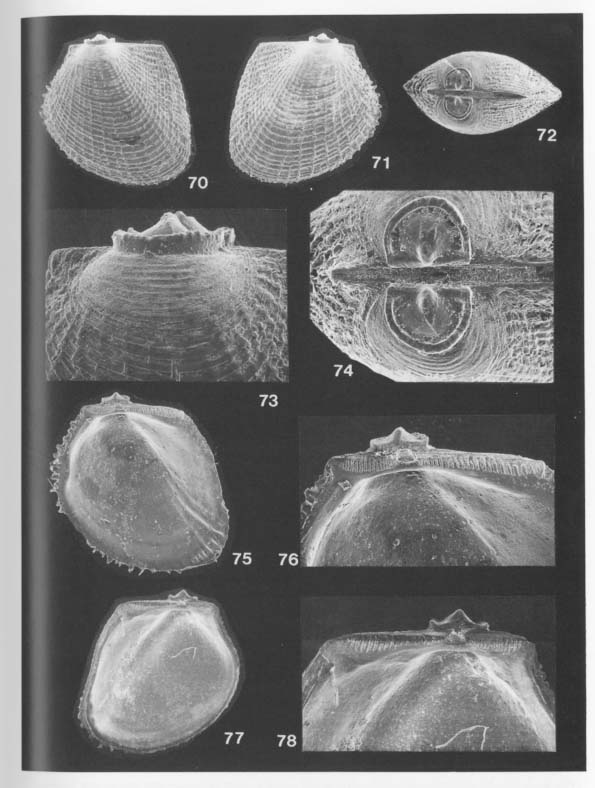Systematic Description
Cosa waikikia (Dall, Bartsch and Rehder)
|
   |
1938. Limopsis waikikia Dall, Bartsch and Rehder, Bernice P. Bishop Mus., Bull., 153, p.42, text-fig.13, pl.7, fig.1.
1979. Limposis waikikia: Kay, Hawaiian Marine Shells, sec.4, p.505, figs.160A, B.
1992. Cosa sp. A, Kase and Hayami,Jour. Moll. Studies, vol.58, p.447, figs.1C, D, p.448, listed.
1993. Cosa sp., Hayami and Kase, Univ. Mus. Univ. Tokyo, News, no.27, p.3, fig.3.
Material.—RM19393 (living) from "Devil's Palace", RM19394 (living) from "Fool's Palace", RM19395 (living) from "Witch's House", RM19584 (living) from "Wall Cave", RM19396 (living) from "Toriike", RM19397 (living) from "Black Hole", RM19583 (living) from "Coral Hole" of Shimoji Islet. RM19398 (living) from "Lunch Hole", RM19399 (living) from "W-arch", RM19400 (living) from "L-arch", RM19401 (living) from "Cross Hole" of Irabu Islet. RM19402 (living) from "Shodokutsu" of Ie Islet. The holotype of this species (USNM no.484219) was dredged off Waikiki, Oahu at 25-50 fathoms.
Description.—Shell small, rarely exceeding 2.0 mm in length and height, light tannish (rarely reddish) in color, roundly trapezoidal, not much elongated, weakly carinate, strongly inflated. Dorsal margin considerably long; anterior margin nearly straight or a little concave, indicating a byssal indentation; posterior margin passes gradually into venter. Umbo orthogyrous, located about one-third of dorsal margin from anterior end. Surface has cancellate ornaments consisting of wide-spaced commarginal lamellae and about 35 weak radial ribs. Periostracum brownish, hairy, well developed on radial ribs. Marginal crenulations absent except for a few near the distal end of posterior carina. Ligament pit triangular, only slightly prosoclinal. Provinculum persistent until the latest growth stage, consisting of about 16 anterior and about 25 posterior subvertical denticles. Adult teeth undeveloped. Pd I large, ranging 243-308 µm in maximum diameter, hat-shaped with pointed central boss and highly elevated and sub vertically truncated brim margin. Pd II absent, though the early part of dissoconch is free from radial ribs and marked with densely spaced commarginal lamellae.
Remarks.—The present species is the most ubiquitous and dominant philobryid in the examined caves; numerous individuals were found alive on the sediment surface, polychaete tubes and surfaces of rock fragments, walls and ceilings. It is easily distin-guishable from other cave species of Cosa by the cancellate ornaments, more posteriorly located umbo and finely frilled and steep brim margin of Pd I.
In every shell character including the size, surface sculpture, periostracum, hinge and prodissoconch, the present specimens are taxonomically indistinguishable from the holotype of Limopsis waikikia Dall, Bartsch and Rehder, 1938, from off Waikiki of Oahu Island, which is surely referable to Cosa. According to Dell (personal commu-nication, March 25, 1993), the original material of Hochstetteria pacifica Thiele in Thiele and Jaeckel (1931) from Samoa, unlike the original line drawing, is, if not identical with, very similar to the Hawaiian species. At present, we regard Cosa waikikia as widely distributed in the tropical-subtropical seas of the western Pacific.
It also resembles an unnamed species, "Cosa sp. II", recorded by Kaneko (1991, p.158, fig. II) from Okinawa in the trapezoidal shell form, non-terminal umbo, cancellate ornaments and many other characters, but the margin of Pd I is less rounded in the present species.
This is evidently a brooding species. Several pre-released embryos, which are identical in shape and size to the Pd I, were actually found in the valves of living specimens (Figures 79, 80). The present materials exhibit a wide range of morphologic variation. A few specimens are tinged with reddish color. The samples from "Fool's Palace" and "Wall Cave" often bear many individuals having thicker periostracum and remarkably concave posterior margin (Figures 81-83). Their taxo-nomic distinction, however, seems to be difficult because the morphologic difference is gradational.
Distribution.—This species has been known from Hawaii, Samoa (?), south Japan. In the Ryukyu Islands, it occurs abundantly in many sublittoral caves of Shimoji, Irabu and Ie Islets. Two left valves which were collected by Mr. Hideharu Tomari from the beach sands at Fukuma, Fukuoka Prefecture, north Kyushu, and now pre-served in the National Science Museum (Tokyo), are also indistinguishable from the present species.